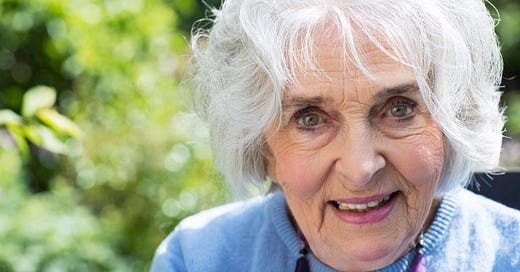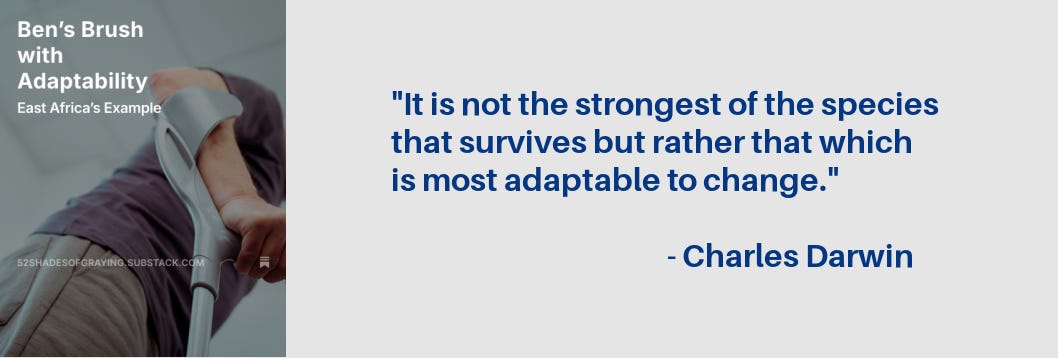Your audio-and-text option:
Listen to Lucy’s story as you read it (below).
Lucy, at 83, had always seen the world in sweeping brush strokes. Majestic mountain ranges, the vast, undulating ocean, the grand expanse of a starry night sky – these were the vistas that had once filled her with awe.
But her central vision, once keen enough to spot a robin's nest from 50 paces, was now a frustrating blur, thanks to macular degeneration.
It felt, at first, like the world was quietly closing in, dimming at the edges of her most cherished memories.
But Lucy didn’t want a little blurring to dim her spirit entirely.
"It's just a different kind of lens, darling," she told her worried daughter, Sarah, who had suggested an ocular therapist. "Perhaps one that focuses on the smaller, more charming details."
Sarah looked skeptical, but Lucy persisted.
Her initial forays into this "new focus" were, admittedly, clumsy. Her morning ritual of reading the newspaper became a comical dance of tilting her head, squinting, and occasionally holding the page an inch from her nose.
She accidentally put salt in her coffee instead of sugar twice in one week, much to the chagrin of her taste buds.
"Well," she mused aloud after one such incident, spitting discreetly into the sink, "at least I'm getting my sodium for the day!"
The real shift began not with conscious effort but with irritation. She was attempting to knit a baby blanket for her great-grandchild, a task that had once brought her immense joy. Now, the tiny stitches blurred into an indistinguishable mess. Her needles, usually a blur of efficient movement, felt like clumsy clubs in her hands.
Frustration mounting, she threw the half-finished blanket onto her lap and sighed. Her gaze, unfocused, landed on the soft, fuzzy texture of the yarn against her fingers. Without thinking, she began to gently stroke it, feeling the individual fibers, the subtle variations in its twist. It wasn't about seeing the perfect stitch anymore; it was about feeling the creation take shape.
She tried it with other things. Her beloved garden, once a riot of color, now appeared as a hazy canvas. Instead of lamenting the indistinct shapes of her prize-winning hydrangeas, she knelt, her knees protesting slightly, and plunged her hands into the soil. The cool dampness, the earthy scent of the compost, the rough stem of a rosebush, the silky petal of a pansy – these sensations flooded her, offering a richness she hadn’t fully appreciated when her eyes had dominated her perception.
She found herself identifying plants by their scent, a fragrant rosemary here, a pungent marigold there.
One sunny afternoon, her grandson, Lain, seven years old and perpetually energetic, burst into her living room. "Grandma! Look what I made!" he exclaimed, holding up a lumpy, painted clay sculpture.
In her old vision, she might have quickly assessed its artistic merit (or lack thereof). Now, she gently took the piece from him, her fingers tracing the uneven surface, the deep thumbprints, the bumpy, dried paint. She felt the cool clay, the slight grit of sand, the small imperfections that made it uniquely Lain’s.
"It's wonderful, dear," she murmured, her voice genuine. "I can feel the effort you put into every single part of it."
Lain, usually more interested in praise than tactile exploration, beamed, seeming to understand her new way of "seeing."
Grocery shopping became an adventure in texture for Lucy. She now runs her hand over a pile of smooth, crisp apples and the ridged surface of a cucumber. She sniffs herbs, distinguishing basil from parsley purely by their scent.
Once, she accidentally picked up a bag of onions instead of potatoes, leading to a rather unconventional potato salad. But even that mishap brought a chuckle. "A new twist on an old classic!" she declared.
Her world wasn't shrinking; it was deepening. The grand vistas might be a soft blur, but the intricate weave of her favorite shawl, the distinct aroma of her freshly brewed tea, the warmth of her cat curled on her lap, the subtle vibrations of a classical music piece – these small, intimate details now held a profound beauty.
Lucy found herself listening more intently, her ears catching the nuanced inflections in a conversation, the distant chirping of crickets, the gentle rustle of leaves in the wind.
She even started taking short pottery classes, finding immense satisfaction in shaping clay with her hands, creating forms she could truly feel and understand.
The macular degeneration hadn't stolen her sight. It had simply taught her to see with more than just her eyes, transforming her experience of the world into a richer, more tactile, tapestry.
She was still Lucy, but now, she was seeing – and feeling – everything from a new, often rewarding, perspective.
Also hear and read Lucy’s “parent story” from 2024
Go to “Ben’s Brush with Adaptability“
Age: Our Greatest Asset!
Jim Hasse, ABC, GCDF retired, author of “52 Shades of Graying”
Weekly Stories About Aging Well
Stories about addressing ageism.
Stories about handling ableism.
Stories about thriving during the second half of life.
Accolade: “Love reading your stories. You never disappoint.” - Mary K.
How to use “My Latest Legacy Nugget” resources to share
your “52 Shades of Graying” comment with a family member or friend.
Template for “My Latest Legacy Nugget” note - birthday
Template for “My Latest Legacy Nugget” note - graduation day
Template for “My Latest Legacy Nugget” note - holiday greeting
Template for “My Latest Legacy Nugget” note - special day
Template for “My Latest Legacy Nugget” note - wedding anniversary
Template for “My Latest Legacy Nugget” note - wedding day
See all past issues of “52 Shades of Graying.”
See all past chats of “52 Shades of Levity.”
Check guidelines for your “52 Shades of Graying” Discussion Group.









I used to be good at walking with my Canadian crutches. In college I could walk a half mile in 15 minutes.
That was important. It meant I could make it between classes as a student with cerebral palsy on the University of Wisconsin - Madison campus In 1965.
But, 60 years later I seldom use my crutches. I prefer my walker because my gait has changed over the years.
In addition to my walker, I now also use a mobility scooter for long distance – an additional mode of mobility I would have used extensively 60 years ago (although there were no curb cuts back then).
* When has an acquired limitation helped you discover vulnerability’s potential for fostering your personal growth?